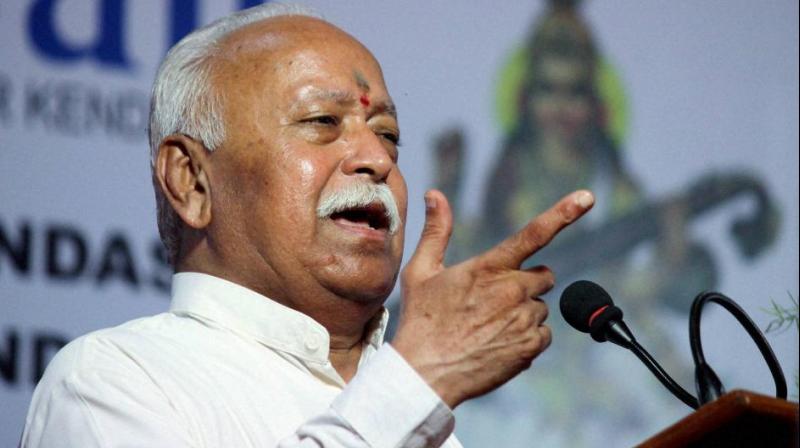BJP, RSS & Ayodhya: The future is unclear

According to Hindustani classical musicologists, the sam is the first beat of the cycle of the system of tal without which compositions cannot move ahead. It has special significance in performance and theory. The sam is also the transition point between lead musicians and the supporting cast. In any performance, if the principal performer is the only one rendering the composition while the accompanist remains in the background, it has the potential becoming monotonous.
As a result, often main musicians take a backseat allowing the accompanying artist, the tabla mostly or an instrumentalist in jugalbandhi, to take the lead. But the secondary performers do not have the liberty to snatch the initiative completely from the main musician. The sam thereby acts as the pivot in this transition between them, the point where the cycle is picked up anew with renewed vigour.
If long-running political campaigns are to be viewed as musical compositions heading for a climactic finish, the sam is the issue to which the movement returns with the completion of every cycle or ascending phase. Another way of framing this argument is that every movement or agitation always has a cementing objective and without this, it runs the risk of dissipating because no agitation can sustain a high pitch constantly. In the national movement, India’s independence from colonial rule was the principal purpose but several other secondary demands were raised in its course because these indirectly bolstered the primary goal.
Yet, time and again the leaders of the national movement returned to the main agenda launching headlong confrontations with British imperialism. Leaders, Mahatma Gandhi downward, were well aware that the intensity of such phases, be it during the Non-Cooperation Movement, the Civil Disobedience agitation or the Quit India Movement, could not be maintained unceasingly. Consequently, there were phases when the national movement was pursued with low intensity, engaging the British administration to seek additional rights and privileges.
From when the Ram Janmabhoomi agitation was launched in 1984, it has functioned as the sam of the movement for installing Hindu nationalism as India’s dominant political credo. The struggle has been waged for this idea to replace inclusive or territorial nationalism — the central idea during the decades-long freedom struggle from which Hindu nationalists were consciously absent. This inclusive approach to Indian nationalism determined India’s post-Independence development policies and acted as the nation’s unifying spirit. For those imagining that building a temple in Ayodhya is all that drives supporters of the stir, it is best to recollect Lal Krishna Advani’s words after the demolition — the agitation is not just constructing a temple but to propagate Hindutva’s foundational idea — cultural nationalism.
The Ayodhya agitation has been a recurring theme to which the Sangh Parivar and its affiliates, most importantly the Bharatiya Janata Party, have returned to. Although the issue was raked up by the Vishwa Hindu Parishad initially, the BJP committed itself to the demand in June 1989 with the adoption of a resolution in Palampur, Himachal Pradesh. This was followed by Mr Advani’s Somnath to Ayodhya rathyatra in September 1990. The benefits were obvious in the Lok Sabha elections in 1989 and 1991. The BJP also secured a majority in the Uttar Pradesh Assembly and formed a government in the state.
From the onset the Sangh Parivar has used the Ayodhya issue as a rallying point. It has also benefited by a surge in growth through programmes like the shilanyas in 1989, the kar seva in 1990 and 1991 and finally in 1992 when the Babri Masjid was demolished. Thereafter, it was a decade before the issue was revived when the next confrontational programme was scheduled. This was perforce abandoned midway due to a Supreme Court directive for maintaining the status quo at the disputed site. Thereafter, there was little effort to organise another confrontational programme in the temple town, suggesting the Sangh Parivar’s realisation that the issue had become one of diminishing returns.
The Ayodhya issue’s return to public discourse with a roar in recent weeks is paradoxical given the setback to the Hindutva movement in the wake of the demolition. To recollect, the BJP learnt cruelly that success in agitations did not necessarily yield electoral benefits — the party lost the 1993 elections in UP and Madhya Pradesh. Additionally, after displaying its aggressive face with Mr Advani at its helm, the Sangh Parivar was forced to replace him with the moderate-faced Atal Behari Vajpayee. After the defeat in 2004, Vajpayee had declared that the BJP’s failed re-election bid was factored by his inability to take action against then Gujarat CM Narendra Modi for his alleged role in the 2002 riots. Although belligerent Hindutva bolstered the agitation on several occasions, it also impeded the acquisition or continuity of political power.
The return of the Ayodhya issue, with a clear certainty of unforeseen developments, suggests possible divergences within the Sangh Parivar over its short-term objectives and long-term goals. There is no doubt that Mr Modi’s primary goal is about his tenure and securing another term, while that of the RSS and other Sangh affiliates are more futuristically oriented. True, RSS chief Mohan Bhagwat has given primacy to politics over character-building, and canvassing votes for the BJP is on his task list for the first time. Yet, because the Hindutva fold is increasingly resembling a saffron rainbow, there are nuanced divergences over what needs to be prioritised, and when.
The RSS has not been part of governance despite having benefited from its decisions and policies. Consequently, Mr Modi has to carry the burden of disenchantment, but the Sangh can’t afford to allow any such resentment to weaken the movement. Raising the pitch on Ayodhya has to be seen in this backdrop. If it comes to choosing between the government and furthering its movement, the RSS will always opt for the latter. And therein lies a key danger for the republic, the government and the BJP. Realpolitik is indeed full of ironies.

